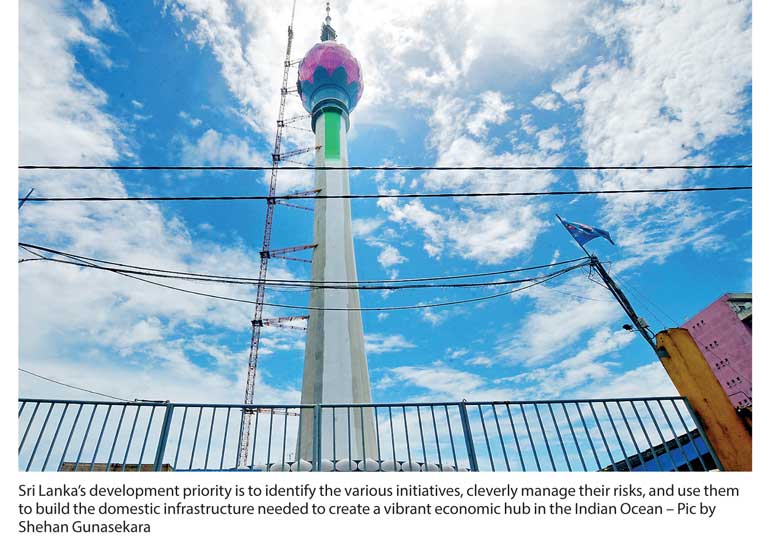Thursday Mar 13, 2025
Thursday Mar 13, 2025
Wednesday, 18 October 2017 00:00 - - {{hitsCtrl.values.hits}}
 China’s Belt and Road Initiative (BRI) – a web of intercontinental road, rail and port links – is a hot topic in Sri Lanka. The debate has focused on the implications of the Hambantota Port and the Colombo International Financial City for maritime security in the Indian Ocean.
China’s Belt and Road Initiative (BRI) – a web of intercontinental road, rail and port links – is a hot topic in Sri Lanka. The debate has focused on the implications of the Hambantota Port and the Colombo International Financial City for maritime security in the Indian Ocean.
Yet the BRI is only one of many initiatives for infrastructure financing that are criss-crossing Asia looking for new markets. Sri Lanka’s development priority is to identify the various initiatives, cleverly manage their risks, and use them to build the domestic infrastructure needed to create a vibrant economic hub in the Indian Ocean.
Asia’s global economic rise over recent decades underlines the economic case for investing in regional infrastructure, which has traditionally linked two countries for trade-led development.
The India-Bangladesh Electrical Grid Interconnection project and the Dushanbe-Uzbekistan regional road in Central Asia are classic examples. Another on the potential drawing board is the so-called ‘Hanuman Bridge’ that may one day link Sri Lanka with South India, if political conditions are right.
There is little doubt that such cross-border projects have contributed to Asia’s economic development, by stimulating flows of goods, services, investment, and people across the borders of neighbouring countries. By improving connectivity, they have also fostered regional peace and cooperation among the region’s small and large countries alike. Safeguards and public policies have been pursued to reduce negative effects from such projects; including displaced people, environmental degradation, and crime.
Asia’s enormous gap of infrastructure financing – reflecting excess demand for regional infrastructure investment and an inadequate supply of infrastructure finance – has also led to several competing ‘mega-regional’ infrastructure initiatives. Being much more ambitious and complex than two-country regional infrastructure projects, these large initiatives will have significant implications for Sri Lanka.
These initiatives are led by Asia’s rising powers, with motives ranging from philanthropic support to develop poorer countries, to narrowly promoting business interests of the state-owned and private national firms of the rising powers.
Key infrastructure projects in the region are: (i) China’s BRI, financed in part by $100 billion in commitments from the Asian Infrastructure Investment Bank, a $40 billion Silk Road Fund, and additional pledges of $129 billion made by President Xi at the Belt and Road Forum in 2017; (ii) Japan’s $100 billion Partnership for Quality Infrastructure; and (iii) ASEAN’s Master Plan for Connectivity, financed through the $500 million ASEAN Infrastructure Fund.
Financial commitments, although not yet determined, are also likely to be significant for the Asia-Africa Growth Corridor, led by India and Japan; the South Korea’s EurAsia Initiative; and Russia’s Trans-Eurasian Belt Development. The EU investment plan, on the other hand, raised $136 billion in investments last year; Asia could potentially benefit from this initiative in the long run.
As Asia’s mega-regional infrastructure initiatives are still in the initial stages of development, information about them is lacking. Some seem better designed than others; with deep project management, high quality engineering solutions, strong buy-in from recipients, and sizeable financial commitments. As good management, engineering, and donor practices spread, laggard initiatives may well emulate their predecessors; a coherent and transparent architecture of mega-regional infrastructure initiatives might one day emerge in Asia.
Aside from an information deficit, multiple and overlapping initiatives in Asia also risk creating a “noodle bowl”  phenomenon. The “noodle bowl” effect, which is more typically associated with free trade agreements (FTAs), refers to a situation in which a growing number of overlapping arrangements generate increasingly complex rules and higher transaction costs for countries and business.
phenomenon. The “noodle bowl” effect, which is more typically associated with free trade agreements (FTAs), refers to a situation in which a growing number of overlapping arrangements generate increasingly complex rules and higher transaction costs for countries and business.
Clearly, there are many shared attributes, as well as differences, between the regional infrastructure initiatives. There are commonalities and differences in their vision, ambition, time horizons, financial commitments, co-financing approaches, and implementation strategies.
Presently, Sri Lanka has limited exposure to mega-regional infrastructure initiatives. The Hambantota Port and the Colombo International Financial City have placed Sri Lanka on the BRI’s map. The upcoming project to develop the Trincomalee city and port is likely to be supported by Japan’s Partnership for Quality Infrastructure, as well as by Singapore and India. Others may try to envelop Sri Lanka in their initiatives once the country’s growth picks up beyond the expected 4.5% for 2017.
The threat of an entangled “noodle bowl” of mega-regional infrastructure initiatives may be exacerbated by three factors.
First, scarce finance may be packaged in a complex and potentially way that could make the noodle bowl effect more pronounced.
Asia needs an estimated $2.5 trillion for infrastructure development between 2016-2030, yet it has limited financial commitments of some $400 billion. Recipients and donors want to stretch these limited funds through innovative financial means; such as by co-financing regional projects with development agencies, state guarantees to incentivise private investors, fully-fledged public private partnerships (PPPs), re-packing of various financing instruments, and crowdfunding. Governments will also need to increase spending for regional infrastructure projects in cash-strapped national budgets.
Indeed, a bewildering array of partnerships and instruments will likely make infrastructure financing more difficult to fathom and to coordinate among the various actors.
Second, mega-regional infrastructure initiatives will likely create winners and losers.
Winners arise when initiatives (i) reinforce comparative advantage reflected in trade and foreign direct investment patterns in Asia, to avoid the risk of “building ports and airports to nowhere”; (ii) are backed by open regionalism initiatives and domestic structural reforms; (iii) incorporate adequate safeguards (e.g. for the environment and resettlement) in formulating projects; and (iv) coordinate among themselves in key areas such as planning, project formulation, procurement practices, financing, and implementation.
Losers from initiatives are hard to predict, as the devil is in the detail for specific projects. Landlocked countries like Nepal, or island states like the Maldives, that are excluded from mega-regional infrastructure initiatives, may be marginalised. The same might apply to distant provinces within countries like Sri Lanka’s hill country, or the north. Some transport routes – either land or maritime transport, for instance – and some workers, such as port workers, may also fail to benefit from efficiency-seeking PPPs.
Ironically, the quest to maximise the benefits of mega-regional infrastructure measures could contribute to the “noodle bowl”. Asian countries should collectively adopt offsetting measures in order to avoid this outcome and mitigate the negative effects of such initiatives. Creating Asian variants of the EU’s regional development funds would address regional development imbalance; these funds are best established under the framework of sub-regional cooperation bodies like ASEAN or BIMSTEC.
Third, mega-regional infrastructure initiatives may pose risks to the debt sustainability, governance, and transparency of participating countries.
Developing countries, with weaker financial capacity and governance, may be more susceptible than richer countries to these risks, and may find that their implementation capacity is overstretched. Some label Sri Lanka – with a total public debt to GDP ratio about 80% in 2016 – as a case of a debt-fuelled, infrastructure strategy.
As more initiatives are established, the likelihood of Asian “noodle bowl” risks increase. Prudent debt management, a strong anti-corruption policy, and capacity building on infrastructure financing help mitigate these risks and realise opportunities in Sri Lanka.
Additionally, Sri Lanka should formulate a national infrastructure development plan to meet its aspiration of becoming an upper middle-income country by 2025 with a targeted per capita income of $ 5,000. Detailing the projects listed in the Government’s recent Vision 2025 document with financing proposals might be the core of this plan. Carefully comparing the financing terms of the plethora of mega-regional infrastructure initiatives with alternatives is another useful step. Blending grant finance with concessionary loan financing would be ideal.
Embedding the financing from mega-regional infrastructure initiatives in on-going IMF/World Bank stabilisation/reform programmes is a difficult but necessary task for infrastructure policy coordination. Finally, in view of the long gestation period of infrastructure projects, initiating a dialogue on infrastructure financing among political parties will help minimise duplication and risks.
The rising powers deserve praise for attempting to solve Asia’s large infrastructure financing problem with mega-regional initiatives. Nevertheless, more thought and time is needed to ensure that these infrastructure initiatives support Sri Lanka’s dream of becoming an Indian Ocean hub.
[Ganeshan Wignaraja is the Chair of the Global Economy Programme at the Lakshman Kadirgamar Institute of International Relations and Strategic Studies (LKI) in Colombo. The opinions expressed in this article are the author’s own. They are not the institutional views of the LKI and do not necessarily represent or reflect the position of any other institution or individual with which the author is affiliated.]
Discover Kapruka, the leading online shopping platform in Sri Lanka, where you can conveniently send Gifts and Flowers to your loved ones for any event including Valentine ’s Day. Explore a wide range of popular Shopping Categories on Kapruka, including Toys, Groceries, Electronics, Birthday Cakes, Fruits, Chocolates, Flower Bouquets, Clothing, Watches, Lingerie, Gift Sets and Jewellery. Also if you’re interested in selling with Kapruka, Partner Central by Kapruka is the best solution to start with. Moreover, through Kapruka Global Shop, you can also enjoy the convenience of purchasing products from renowned platforms like Amazon and eBay and have them delivered to Sri Lanka.
Discover Kapruka, the leading online shopping platform in Sri Lanka, where you can conveniently send Gifts and Flowers to your loved ones for any event including Valentine ’s Day. Explore a wide range of popular Shopping Categories on Kapruka, including Toys, Groceries, Electronics, Birthday Cakes, Fruits, Chocolates, Flower Bouquets, Clothing, Watches, Lingerie, Gift Sets and Jewellery. Also if you’re interested in selling with Kapruka, Partner Central by Kapruka is the best solution to start with. Moreover, through Kapruka Global Shop, you can also enjoy the convenience of purchasing products from renowned platforms like Amazon and eBay and have them delivered to Sri Lanka.